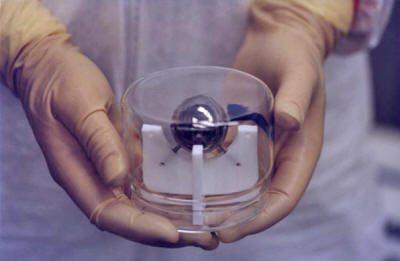|
|
|
from ScienceNASA Website
There is a space-time vortex around
Earth, and its shape precisely matches the predictions of Einstein's
theory of gravity.
measuring the curved space-time around Earth. [more]
An expert in Einstein's theories, Will chairs an independent panel of the National Research Council set up by NASA in 1998 to monitor and review the results of Gravity Probe B.
Time and space, according to Einstein's theories of relativity, are woven together, forming a four-dimensional fabric called "space-time."
The mass of Earth dimples this fabric,
much like a heavy person sitting in the middle of a trampoline.
Gravity, says Einstein, is simply the motion of objects following
the curvaceous lines of the dimple.
In practice, the experiment is tremendously difficult.
One of the super-spherical gyroscopes of Gravity Probe B.
[more]
The four gyroscopes in GP-B are the most perfect spheres ever made by humans.
These ping pong-sized balls of fused
quartz and silicon are 1.5 inches across and never vary from a
perfect sphere by more than 40 atomic layers. If the gyroscopes
weren't so spherical, their spin axes would wobble even without the
effects of relativity.
It's like measuring the thickness of a sheet of paper held edge-on 100 miles away.
They developed a "drag free" satellite that could brush against the outer layers of Earth's atmosphere without disturbing the gyros.
They figured out how to keep Earth's
magnetic field from penetrating the spacecraft. And they created a
device to measure the spin of a gyro - without touching the gyro.
More information about these technologies may be found in the
Science@NASA story "A
Pocket of Near-Perfection."
But after a year of data-taking and nearly five years of analysis, the GP-B scientists appear to have done it.
For readers who are not experts in relativity: Geodetic precession is the amount of wobble caused by the static mass of the Earth (the dimple in space-time) and the frame dragging effect is the amount of wobble caused by the spin of the Earth (the twist in space-time).
Both values are in precise accord with Einstein's predictions.
An artist's concept of twisted spacetime around a black hole.
Credit: Joe Bergeron
of Sky & Telescope magazine.
The results of Gravity Probe B give physicists renewed confidence that the strange predictions of Einstein's theory are indeed correct, and that these predictions may be applied elsewhere.
The type of space-time vortex that exists around Earth is duplicated and magnified elsewhere in the cosmos - around massive neutron stars, black holes, and active galactic nuclei.
In binary black hole systems - that is, where one black hole orbits another black hole - the black holes themselves are spinning and thus behave like gyroscopes.
Imagine a system of orbiting, spinning,
wobbling, flipping black holes! That's the sort of thing general
relativity predicts and which GP-B tells us can really be true.
The project also touched the lives of hundreds of young scientists:
NASA funding for Gravity Probe B began in the fall of 1963.
That means Francis Everitt and some colleagues
have been planning, promoting, building, operating, and analyzing
data from the experiment for more than 47 years - truly, an epic
effort.
This epic might just be getting started,
after all….
|




